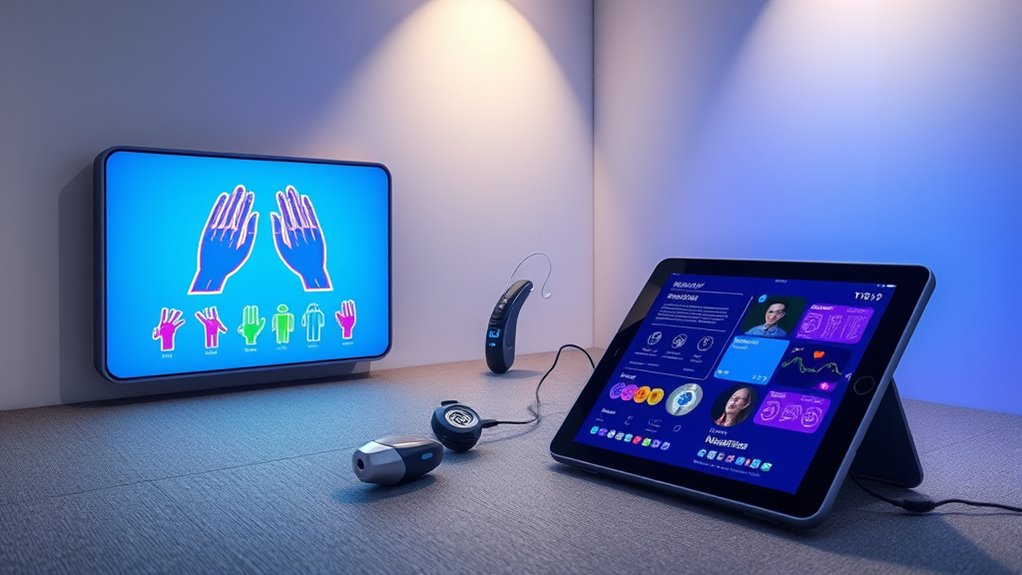The latest gadgets for deaf accessibility include wearable devices like vibration jewelry and sign language translation gloves that turn gestures into speech, helping you communicate effortlessly. Smart home systems now feature visual alerts and vibrating alarms to keep you safe, while real-time captioning apps and video relay services improve conversations. AI-powered sign language translators and advanced hearing devices enhance understanding, giving you more independence. Keep exploring to discover even more innovative tools designed to support your everyday life.
Key Takeaways
- Wearable devices like vibrotactile shirts and sign language gloves offer real-time environmental sound translation.
- Smart home alert systems with visual and vibrating signals enhance safety and independence.
- AI-powered captioning apps and video relay services improve communication for the deaf community.
- Discreet alerting gadgets, such as vibrating jewelry and hairpin sensors, notify users of environmental cues.
- Future innovations include AI-driven sign language translation and adaptive hearing devices for clearer sound.
Wearable Devices Enhancing Sensory Awareness
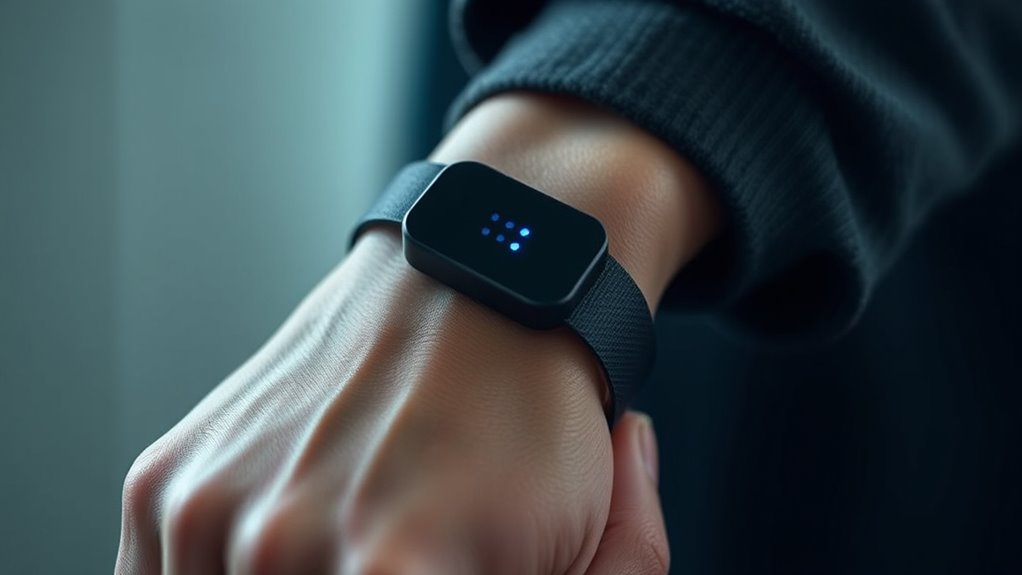
Wearable devices are revolutionizing sensory awareness for deaf individuals by providing discreet and real-time feedback. With assistive technology like vibrating alarms and wristbands, you can receive discreet notifications for alarms, doorbells, or environmental sounds without drawing attention.
Wearable devices discreetly provide real-time sensory alerts, enhancing awareness for deaf individuals.
Sign language translation gloves equipped with sensors convert gestures into speech or visual cues, making communication seamless.
Sensory awareness wearables, such as vibration jewelry or tactile devices, translate environmental sounds, music, or alarms into vibrations you can feel, enhancing your perception of surroundings. These innovations often utilize assistive technology to improve safety and independence. Incorporating wearable sensors can further refine the accuracy and responsiveness of these devices.
Additionally, these devices often incorporate emotional support principles by helping users feel more connected and less isolated in their environments, which is crucial for emotional well-being. Compact options like hairpin sensors or vibrotactile shirts deliver tactile signals, helping you monitor your environment more effectively.
These devices empower you to stay aware of important auditory cues, boosting safety, independence, and overall sensory connection in daily life. Advancements in assistive technology continue to expand possibilities for improved sensory perception and connection.
Smart Home Alerting Systems for Safety and Independence
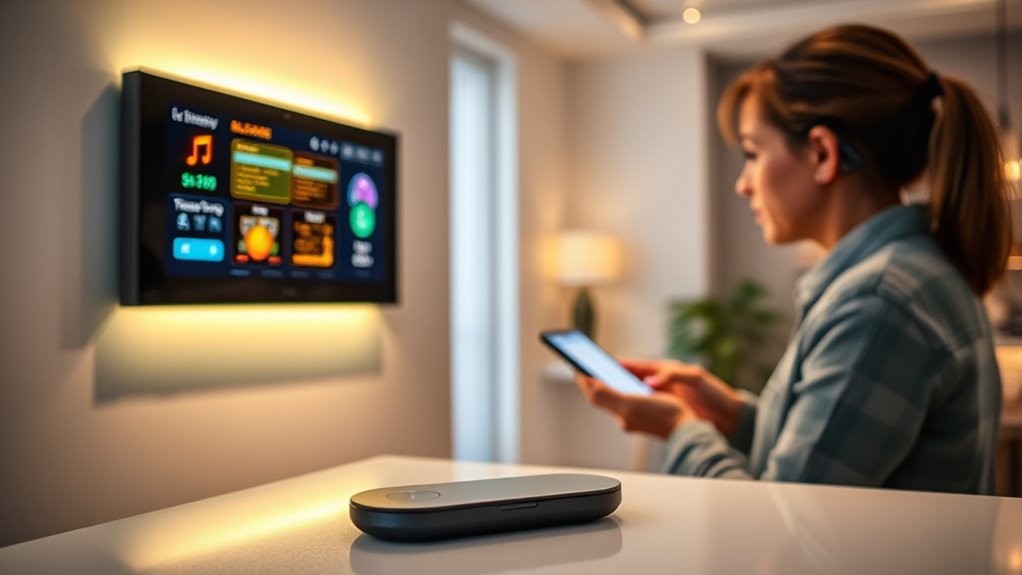
Smart home alerting systems markedly enhance safety and independence for deaf individuals by providing reliable, immediate notifications during emergencies. These systems integrate alerting devices like ADA-compliant smoke detectors with strobe lights and vibrating alarms, ensuring you’re aware of dangers without relying on sound.
Wireless video doorbells such as Ring, Nest, and Alexa deliver visual alerts through flashing lights or smartphone notifications when visitors arrive, improving connectivity and awareness. Additionally, many systems offer customizable alert settings to tailor notifications to individual needs, further increasing their effectiveness. Incorporating smart technology into these systems allows for seamless integration with other home devices, creating a comprehensive safety network.
Light-based alerting devices connected to home security systems signal break-ins or alarms via visual cues, boosting safety. You can customize alerts for specific sounds and control them remotely through mobile apps, empowering your independence. Integration with home networks ensures these alerting systems work harmoniously with existing smart devices, enhancing overall safety. Building on this, AI Security can analyze patterns and provide more timely alerts, further safeguarding users. These features work together seamlessly to create a safer, more accessible smart home environment for those with hearing loss.
Advanced Communication Platforms and Captioning Technologies
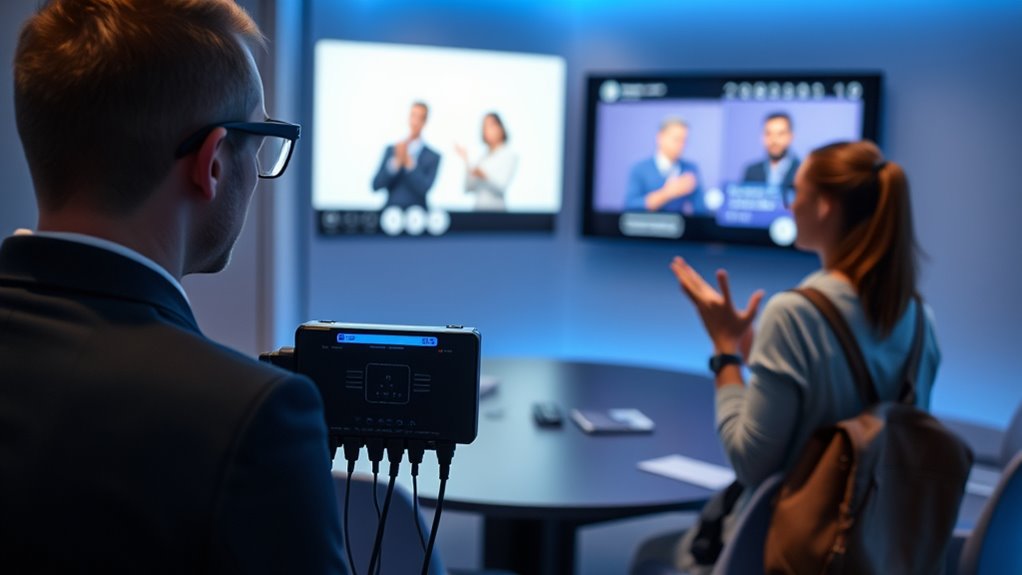
Advanced communication platforms and captioning technologies are transforming how deaf individuals connect and access information. Real-time transcription apps like Nagish instantly convert phone calls and notifications, making communication seamless. Vetted wave and wind ensure these tools are reliable and effective for daily use. AI-driven platforms like Sign-Speak translate sign language videos into accurate captions, broadening media accessibility. Video relay services (VRS) enable you to communicate via sign language interpretation over video calls, bridging the gap with hearing people. Captioning features integrated into streaming platforms like Netflix and Disney+ use AI to overlay ASL or text, making content more inclusive. Hearing aids and smart device connectivity allow your devices to sync with smartphones and TVs, providing synchronized captioning and clearer audio. These innovations empower you to stay connected, informed, and engaged effortlessly.
Innovative Devices Supporting Daily Living and Parenting
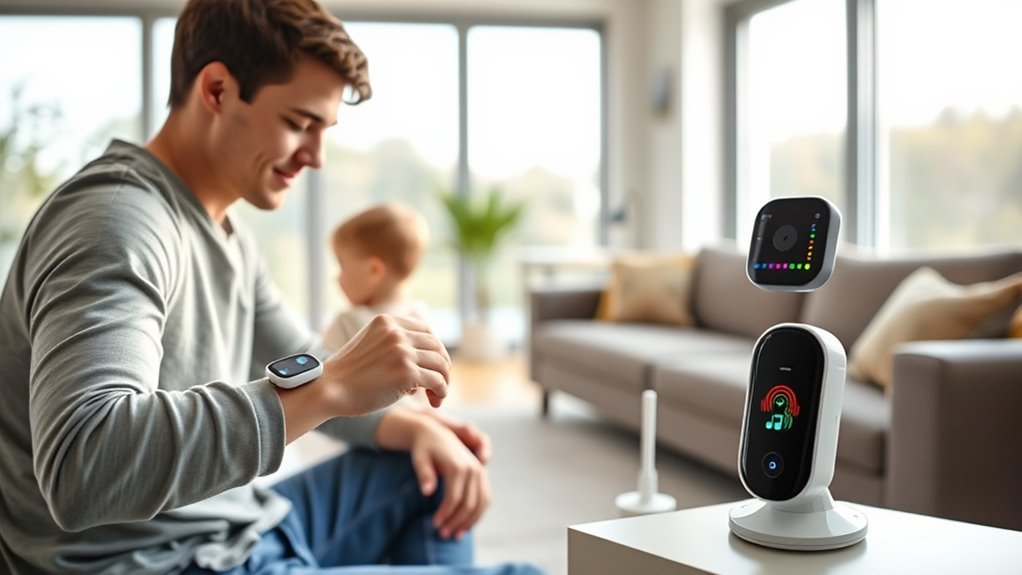
Innovative devices are transforming how deaf individuals manage daily routines and parenthood, offering new levels of independence and safety. With advanced deaf technology, you can stay connected and respond promptly to environmental cues. For example, sign-iO smart gloves translate sign language into speech, improving communication with others. Vibration-based alert systems, like vibrating alarm clocks and hairpin sensors, discreetly notify you of doorbells or alarms, supporting daily routines. Visual alerts, such as flashing doorbells and light bulbs, enhance safety at home and in social settings. Additionally, some devices incorporate forsale 100 features to improve accessibility and affordability for users seeking reliable technology solutions. Parenting tools like the Owlet Smart Sock and Twinbees app monitor your baby’s essential signs and sounds, allowing for quick responses. These innovative hearing aids, alert systems, and communication devices empower you to navigate daily living and parenting confidently.
Future Trends in Deaf Technology: AI and Machine Learning
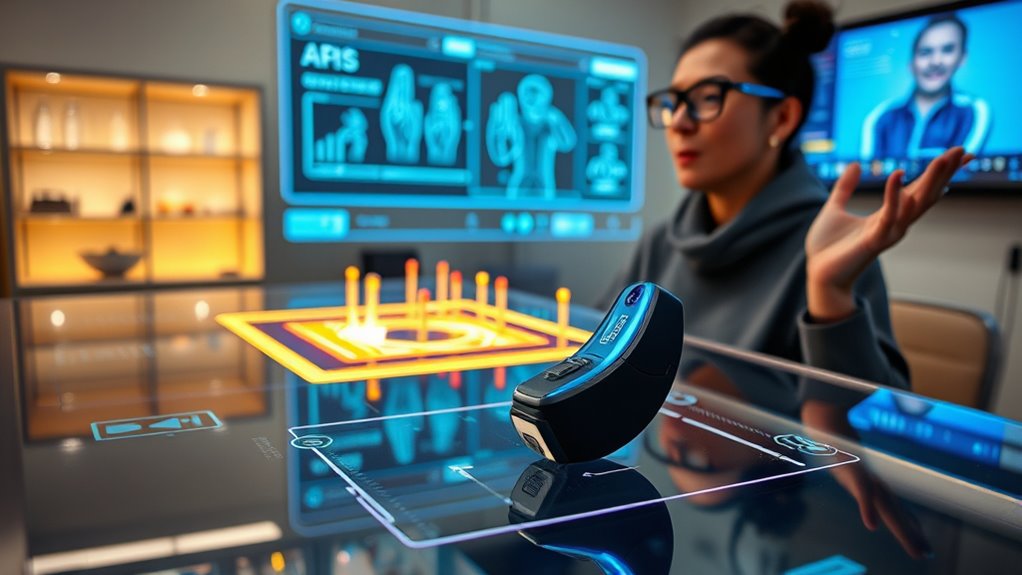
AI and machine learning are transforming deaf technology by enabling real-time sign language translation that instantly converts gestures into speech or text. This innovation improves communication and independence. Advanced captioning systems powered by AI can generate accurate, context-aware subtitles for live content, reducing reliance on manual input. Moreover, machine learning algorithms also enhance personalized hearing devices by adapting to different environments, improving clarity, and minimizing background noise. Additionally, AI-driven virtual interpreters and sign language avatars provide scalable solutions for remote interpretation. Predictive alerts are another breakthrough, detecting environmental sounds and notifying users via visual or vibrational cues before events happen. Environmental sound recognition is advancing rapidly, allowing devices to better interpret complex acoustic environments and adaptive learning helps these systems become more precise over time. Developing user-centered design principles ensures that these technologies are accessible, intuitive, and meet the diverse needs of deaf users. Incorporating inclusive technology strategies ensures that innovations are accessible to a broad range of users, fostering greater independence and engagement. Furthermore, ongoing research into sound classification algorithms promises even more accurate environmental awareness for users in real-world settings.
Frequently Asked Questions
What Is the New Technology for Deaf People?
You’re wondering about new technology for deaf people. These innovations include wearable devices like smart gloves and shirts that translate sign language into speech or text instantly.
AI tools such as Hearingbot and Ontenna convert environmental sounds into visual or vibrational alerts.
Advanced Bluetooth-enabled hearing aids connect effortlessly to your devices, while visual alert systems and digital platforms like video relay services improve communication and safety.
These advancements make everyday life more accessible and connected.
What Is the Best Assistive Technology for Hearing Impaired People?
Did you know that over 5% of the world’s population has hearing loss?
When it comes to the best assistive tech, it depends on your needs.
You might find Bluetooth-enabled hearing aids and real-time captioning apps helpful, or prefer vibrating alerts for safety.
High-tech options like cochlear implants with streaming accessories offer seamless connectivity.
Choose what fits your environment, comfort, and lifestyle to stay connected and independent.
What Are the Accessibility Devices for Deaf People?
You want to know about accessibility devices for deaf people. These include alerting systems with flashing lights, vibrations, and visual signals for alarms and notifications.
Hearing assistive technologies like FM, infrared, and loop systems deliver clear sound directly to your hearing aids or cochlear implants.
Personal devices such as amplified phones, captioning apps, and video relay services help you communicate effectively.
Wearables like sign language gloves and vibration alerts also enhance environmental awareness.
What Is the Wearable Technology for Deaf People?
When it comes to wearable technology for deaf people, you’re in luck—there’s a lot on the horizon. You can wear smart gloves and shirts with sensors that turn sign language into speech or visuals.
Vibrating accessories and haptic devices help you perceive sounds through touch, while jewelry like Vibeat offers a tactile experience of music. These gadgets put you ahead of the curve, making communication more accessible and seamless.
Conclusion
As you explore these groundbreaking gadgets, you’ll discover how they can transform your daily life, making independence feel like second nature. These innovations aren’t just upgrades—they’re game-changers that open possibilities you never thought possible. With AI and machine learning leading the charge, the future of deaf accessibility is brighter than a thousand suns. Embrace these technologies and experience a world where communication and safety become seamless, empowering you to live fully and confidently every day.

